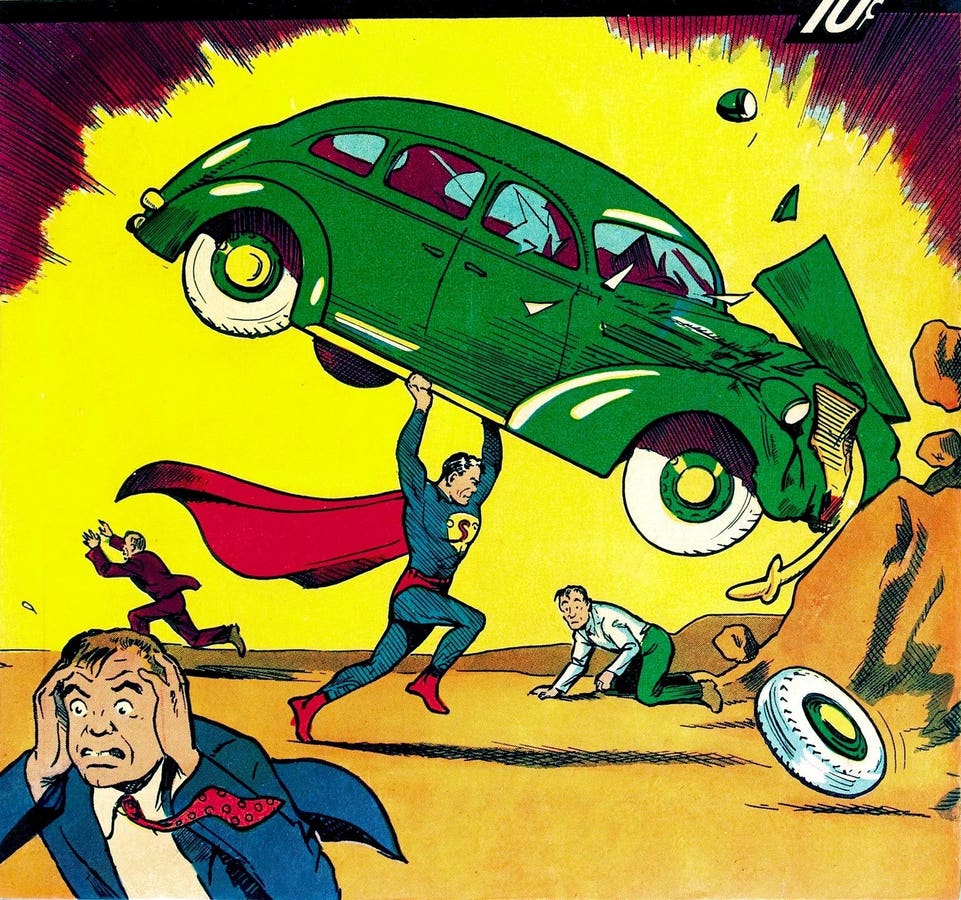Faster than a speeding bullet, more powerful than a locomotive, able to leap out of a market slump in a single bound! Superman, whose first appearance in 1938 kickstarted the comic book business in the United States, is flying to the rescue of a comics and collectibles industry mired in a post-COVID funk. One of the best known copies of the Man of Steel’s inaugural adventures is setting new records in an ongoing Heritage Auction and prying open the wallets of deep-pocketed collectors for items across the entire catalog.
Action Comics #1, featuring the first appearance of Superman, has long been the most desirable American comic book, bringing record prices whenever one of the extremely small number of surviving copies goes up for sale. This month’s auction for one of the three best unrestored copies known to exist, professionally certified in 8.5 (out of 10) condition, is no exception. With a current high bid of $4.2 million (over $5 million after buyers’ premium), and the hammer not coming down until April 4, the action around this item and other rare art and collectibles up for sale this month shows that enthusiasm and values for blue chip collectibles remains high, despite anecdotal evidence of a prolonged slump in prices across the market more broadly.
So far, the bidding is in line with pre-auction expectations, according to Barry Sandoval, VP for Comics at Heritage Auctions. “I would have been more surprised if we hadn’t gotten to this number, but it’s always gratifying to get there this far in advance of the live session [April 4],” he said in a phone interview. “We think it still has a little ways to go.”
The current auction led by the pedigree Action #1 also features other items of interest to high-end collectors, including a very high grade copy of the first appearance of Iron Man, and lower-grade or restored copies of many other highly prized comics. Sandoval says that the prospect of being part of an auction likely to realize the highest price ever for a single comic book issue was a good incentive to bring material out of the attic and up for sale.
Underground comix artist and publisher Denis Kitchen has put the bulk of his extensive collection of original artwork on the block, including work by legendary creators like Will Eisner, Robert Crumb, Harvey Kurtzman, and Kitchen himself. Aside from the artwork, a rare Superman-related historical artifact from Kitchen’s archive is also drawing attention.
That item is a three-page document from 1934 that completely upends our previous understanding of the creation of Superman: a typed letter signed by Jerry Siegel, one of The Man of Tomorrow’s co-creators, suggesting that Siegel was looking at someone besides eventual artistic co-creator Joe Shuster to collaborate with: Buck Rogers cartoonist Russell Keaton. Siegel and Keaton two worked together on a vastly different version of Superman that never saw the light of day, rooted much more heavily in the pulp science fiction of the era.
Kitchen discovered the letter on a visit with Keaton’s widow in the late 1980s, and copies surfaced as part of legal proceedings over the past decades, but the original has never been publicly seen, much less made available for sale.
“Neither she nor I thought the letter of value other than historical value,” Kitchen says. “Over the years, if anything, the historical significance has only grown as you see Siegel’s first thoughts about the Superman we know — and the one we almost knew. And keep in mind that Siegel was only 19 when he wrote that letter, making it all the more remarkable.”
“Nobody knows what kind of number to put on it,” said Sandoval. “It’s always interesting when you have something that’s out of nowhere, that most people have never seen or heard of, or could even conceive might exist.” Sandoval noted that Heritage conducts auctions in autographs and historical manuscripts, which cater to a different set of collectors and have different market dynamics, but that this particular item might have crossover appeal. “As a comic guy, it’s pretty cool to see Jerry Siegel’s document getting numbers comparable to presidential autographs or letters from historical figures.”
Another recent Heritage auction also got good results. Author Neil Gaiman hosted a special event featuring art and memorabilia from his 35 year career, including many one of a kind items like a depiction of the Sandman character Death by the late French artist Moebius, which sold for over $85,000. Whether it was the quality of the merchandise on offer or the prestigious provenance that was driving the bidding, the event cleared over $1 million.
The buzz and apparent success of these high profile auctions flies in the face of the narrative that has driven the collectibles market for the past two years, as the huge prices realized for second- and third-tier collectibles during the pandemic have come crashing down to earth. Collectors on forums and on YouTube have documented prices for “key books” featuring first appearances, important story turns or notable artwork, declining not just below previous levels, but sometimes below the costs of getting the comics graded and encapsulated in plastic “slabs.”
Sandoval says Heritage has noticed the trend in the weekly comics auctions that the site holds online. “The prices for things that are more generic [than Superman or Spider-Man’s first appearance] have softened,” he said. “They’re down from 2021, but they have still grown from pre-pandemic prices.”
He said there is also less collector enthusiasm for recent comics and issues featuring characters rumored to be part of movies or TV series, perhaps owing to “superhero fatigue” seen at the box office.
“It’s still a seller’s market, especially if you take the long view [of price appreciation],” he said. “Every collector has stories about missing out on an item where the price seemed high at the time, and now looks like a bargain.”
Sandoval and others in the industry hope headline-making sales and unique items will continue to bring money off the sidelines and into the bidding. No-minimum bid auctions, especially for highly desired items, tends to attract bargain hunters eager to put in early bids on books that may eventually go for big money. According to Sandoval, about 1400 different people placed bids in the auctions ending next week.
Read the full article here




